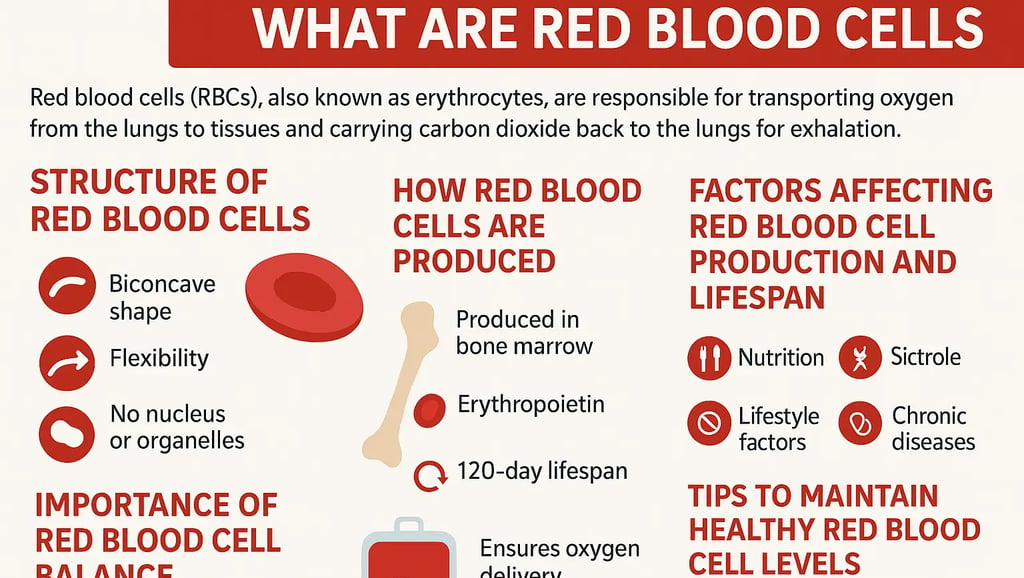What Are Red Blood Cells (RBCs)? Structure, Function, and Health Tips
Learn what red blood cells (RBCs) are, their structure, functions, production process, and tips to maintain healthy RBC levels for better oxygen transport and overall health.


What Are Red Blood Cells (RBCs)? Functions, Importance, and Health Tips
Red blood cells (RBCs), also called erythrocytes, are the most abundant type of blood cells in the human body. They play a critical role in the circulatory system by transporting oxygen from the lungs to tissues and carrying carbon dioxide back to the lungs for exhalation. This exchange of gases is essential for energy production, metabolism, and overall health.
Structure of Red Blood Cells
The structure of RBCs is perfectly adapted for their function:
Biconcave shape – This increases the surface area, allowing for efficient oxygen and carbon dioxide exchange.
Flexibility – Their shape enables them to pass through tiny capillaries smoothly.
No nucleus or organelles – This provides more room for hemoglobin, the iron-rich protein that binds to oxygen.
Red color – Hemoglobin gives red blood cells their distinct color and is also responsible for the red appearance of arterial blood.
How Red Blood Cells Are Produced
Red blood cells are made in the bone marrow through a process called erythropoiesis. The hormone erythropoietin, produced by the kidneys, stimulates their production, especially when oxygen levels in the blood are low.
A healthy adult produces millions of new RBCs every day.
The average lifespan of an RBC is about 120 days.
Old or damaged RBCs are broken down in the spleen and liver.
This constant cycle ensures a steady oxygen supply to the body.
Importance of Red Blood Cell Balance
Keeping the right balance of red blood cells is vital for good health:
Low RBC count (Anemia): Causes fatigue, weakness, dizziness, shortness of breath, and poor concentration. Severe anemia may lead to heart complications and reduced immunity.
High RBC count (Polycythemia): Thickens the blood, increasing risks of blood clots, stroke, and heart attack. Symptoms may include headaches, dizziness, and blurred vision.
Maintaining an optimal RBC level ensures efficient oxygen delivery, energy production, and overall homeostasis.
Factors Affecting Red Blood Cell Production and Lifespan
Several factors influence how red blood cells are produced and how long they survive:
Nutrition
Iron: Essential for hemoglobin; deficiency leads to iron-deficiency anemia.
Vitamin B12: Needed for DNA synthesis in RBCs; deficiency causes megaloblastic anemia.
Folic Acid: Important for proper cell division and RBC production.
Chronic Diseases
Kidney disorders reduce erythropoietin production.
Cancers and autoimmune conditions may impair bone marrow function.
Genetic Conditions
Disorders like sickle cell anemia and thalassemia affect RBC shape, function, and lifespan.
Lifestyle Factors
Smoking reduces oxygen delivery.
Exercise improves circulation and overall blood health.
Hydration supports proper blood flow and oxygen transport.
Tips to Maintain Healthy Red Blood Cell Levels
You can naturally support healthy RBC production and function by following these tips:
✅ Eat a balanced diet rich in iron (spinach, lean meats, beans), vitamin B12 (eggs, dairy, fish), and folate (leafy greens, legumes, fortified cereals).
✅ Stay hydrated by drinking enough water daily to support circulation.
✅ Exercise regularly with activities like walking, swimming, or cycling to improve blood health.
✅ Get routine blood tests such as a complete blood count (CBC) to monitor RBC levels.
✅ Seek medical advice if you experience fatigue, weakness, or breathing difficulties, as these may signal anemia or other blood-related issues.
Conclusion
Red blood cells are the lifeline of the human body, ensuring oxygen reaches every cell and organ. Maintaining a healthy balance of RBCs through proper nutrition, lifestyle choices, and medical monitoring is essential for long-term health and vitality.
By understanding how RBCs work and taking proactive steps to support their production, you can protect your energy levels, immunity, and overall well-being.
